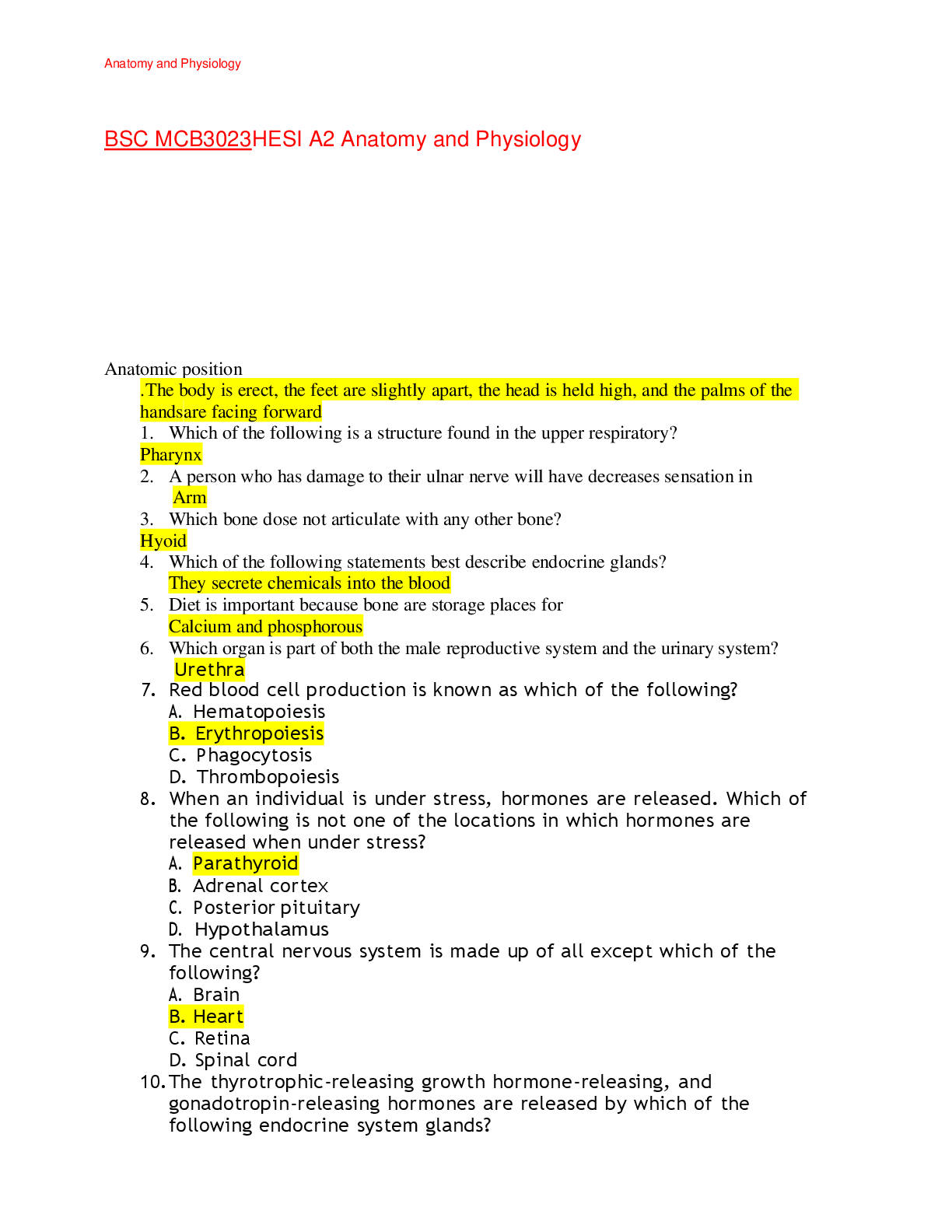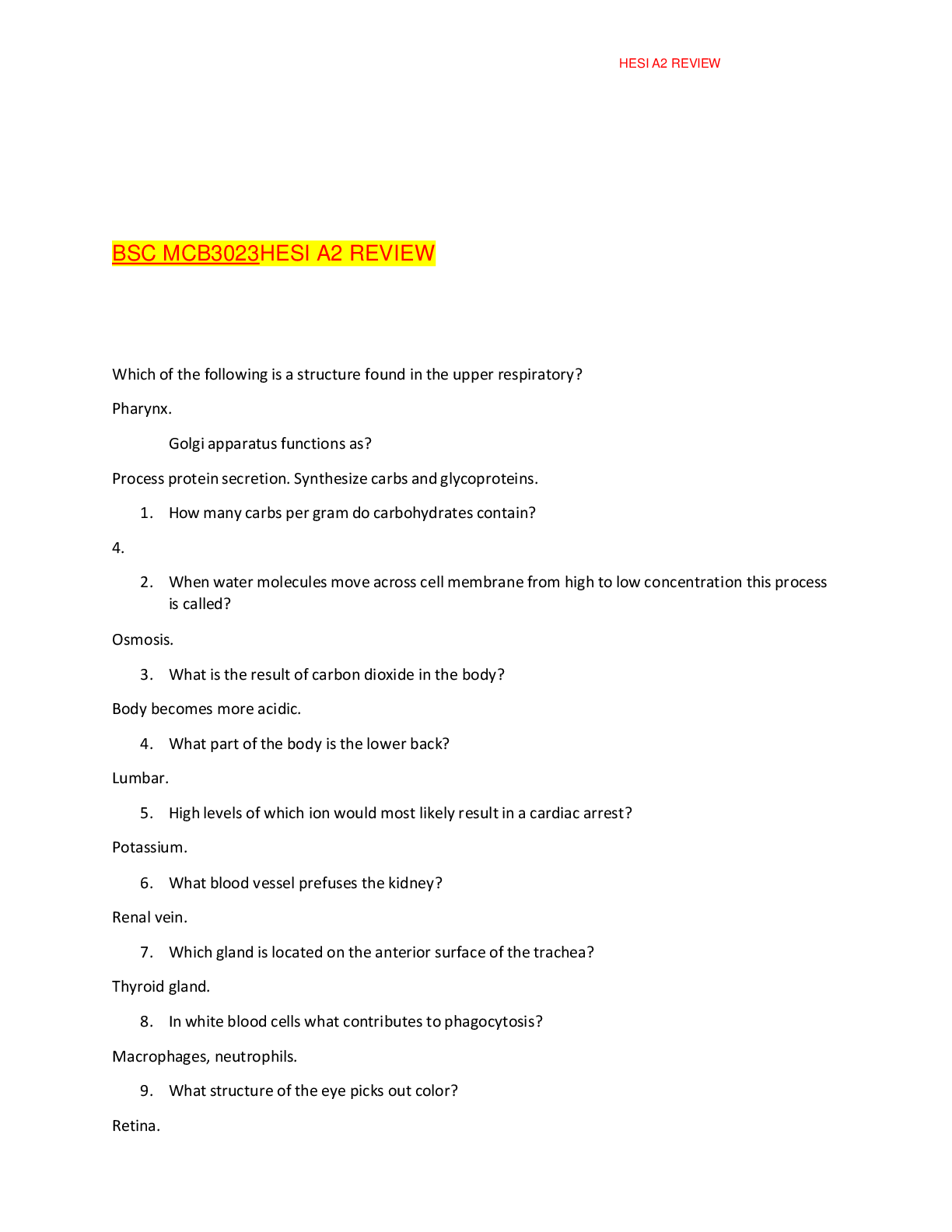*NURSING > HESI > Hesi Study Module 9 Exam Questions And Answers Plus Rationales ( Complete Solution Rated A)Top score (All)
Hesi Study Module 9 Exam Questions And Answers Plus Rationales ( Complete Solution Rated A)Top score
Document Content and Description Below
Hesi Study Module 9 Questions 1. ID: 8482572285A client who has undergone abdominal surgery calls the nurse and reports that she just felt “something give way” in the abdominal incision. The nurse ... checks the incision and notes the presence of wound dehiscence. The nurse immediately: Contacts the physician Documents the findings Places the client in a supine position with the legs flat Covers the abdominal wound with a sterile dressing moistened with sterile saline solution Correct Rationale: Wound dehiscence is the disruption of a surgical incision or wound. When dehiscence occurs, the nurse immediately places the client in a low Fowler’s position or supine with the knees bent and instructs the client to lie quietly. These actions will minimize protrusion of the underlying tissues. The nurse then covers the wound with a sterile dressing moistened with sterile saline. The physician is notified, and the nurse documents the occurrence and the nursing actions that were implemented in response. Test-Taking Strategy: Use the process of elimination and note the strategic word “immediately.” Visualize this occurrence and recall that the primary concern when wound dehiscence occurs is the protrusion of underlying tissues. This will direct you to the correct option. Review the nursing actions to be taken immediately in the event of wound dehiscence if you had difficulty with this question. Level of Cognitive Ability: Applying Client Needs: Physiological Integrity Integrated Process: Nursing Process/Implementation Content Area: Perioperative Care Reference: Ignatavicius, D., & Workman, M. (2010). Medical-surgical nursing: Patient-centered collaborative care (6th ed., pp. 291, 292, 296). St. Louis: Saunders. Awarded 1.0 points out of 1.0 possible points. 2. ID: 8482572275A client who just returned from the recovery room after a tonsillectomy and adenoidectomy is restless and her pulse rate is increased. As the nurse continues the assessment, the client begins to vomit a copious amount of bright-red blood. The immediate nursing action is to: Notify the surgeon Correct Continue the assessment Check the client’s blood pressure Obtain a flashlight, gauze, and a curved hemostat Rationale: Hemorrhage is a potential complication after tonsillectomy and adenoidectomy. If the client vomits a large amount of bright-red blood or the pulse rate increases and the patient is restless, the nurse must notify the surgeon immediately. The nurse should obtain a light, mirror, gauze, curved hemostat, and waste basin to facilitate examination of the surgical site. The nurse should also gather additional assessment data, but the surgeon must be contacted immediately. Test-Taking Strategy: Focus on the data in the question. Noting the words “bright- red blood” will assist in directing you to the correct option. Remember that the presence of bright-red blood indicates active bleeding. Review the nursing actions to be taken immediately when bleeding occurs after a tonsillectomy and adenoidectomy if you had difficulty with this question. Level of Cognitive Ability: Applying Client Needs: Physiological Integrity Integrated Process: Nursing Process/Implementation Content Area: Delegating/Prioritizing Reference: Ignatavicius, D., & Workman, M. (2010). Medical-surgical nursing: Patient-centered collaborative care (6th ed., p. 657). St. Louis: Saunders. Awarded 1.0 points out of 1.0 possible points. 3. ID: 8482570090A client who has just undergone surgery suddenly experiences chest pain, dyspnea, and tachypnea. The nurse suspects that the client has a pulmonary embolism and immediately sets about: Preparing the client for a perfusion scan Attaching the client to a cardiac monitor Administering oxygen by way of nasal cannula Correct Ensuring that the intravenous (IV) line is patent Rationale: Pulmonary embolism is a life-threatening emergency. Oxygen is immediately administered nasally to relieve hypoxemia, respiratory distress, and central cyanosis, and the physician is notified. IV infusion lines are needed to administer medications or fluids. A perfusion scan, among other tests, may be performed. The electrocardiogram is monitored for the presence of dysrhythmias. Additionally, a urinary catheter may be inserted and blood for arterial blood gas determinations drawn. The immediate priority, however, is the administration of oxygen. Test-Taking Strategy: Focus on the client’s diagnosis and use the skills of prioritizing. Apply the ABCs (airway, breathing, and circulation) to find the correct option. Review the nursing actions to be taken immediately in the event of pulmonary embolism if you had difficulty with this question. Level of Cognitive Ability: Applying Client Needs: Physiological Integrity Integrated Process: Nursing Process/Implementation Content Area: Delegating/Prioritizing Reference: Ignatavicius, D., & Workman, M. (2010). Medical-surgical nursing: Patient-centered collaborative care (6th ed., p. 680). St. Louis: Saunders [Show More]
Last updated: 3 years ago
Preview 1 out of 39 pages
 (1).png)
Buy this document to get the full access instantly
Instant Download Access after purchase
Buy NowInstant download
We Accept:

Reviews( 0 )
$16.50
Can't find what you want? Try our AI powered Search
Document information
Connected school, study & course
About the document
Uploaded On
Mar 11, 2022
Number of pages
39
Written in
All
Additional information
This document has been written for:
Uploaded
Mar 11, 2022
Downloads
0
Views
163



 (1).png)
 (1).png)
 (1).png)
 (1).png)
 (1).png)
 (1).png)
 (1).png)














